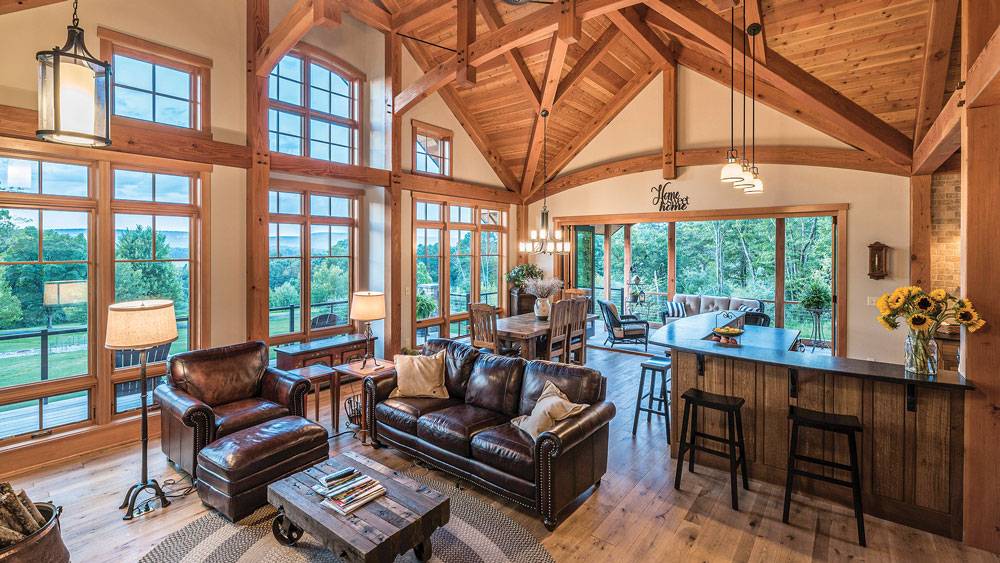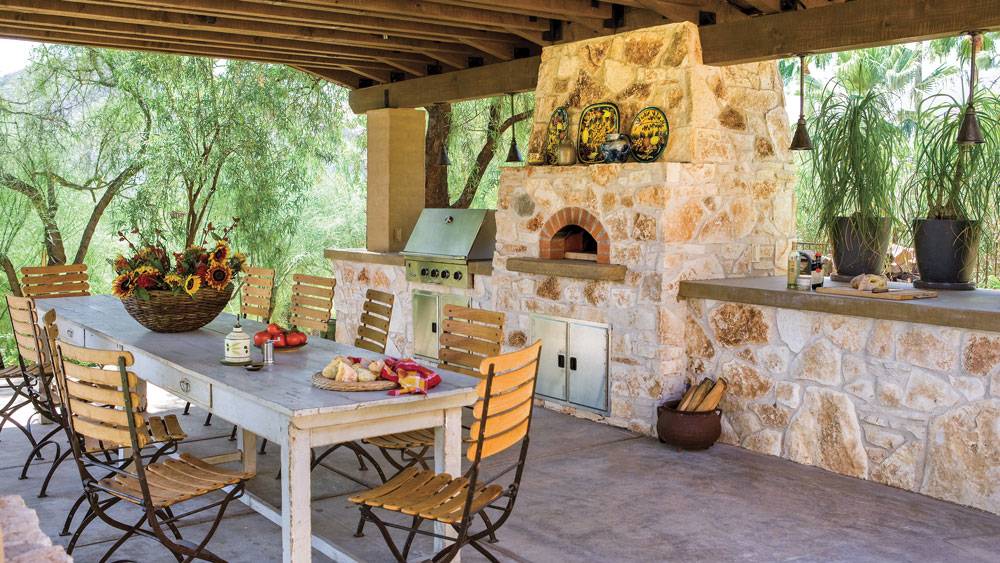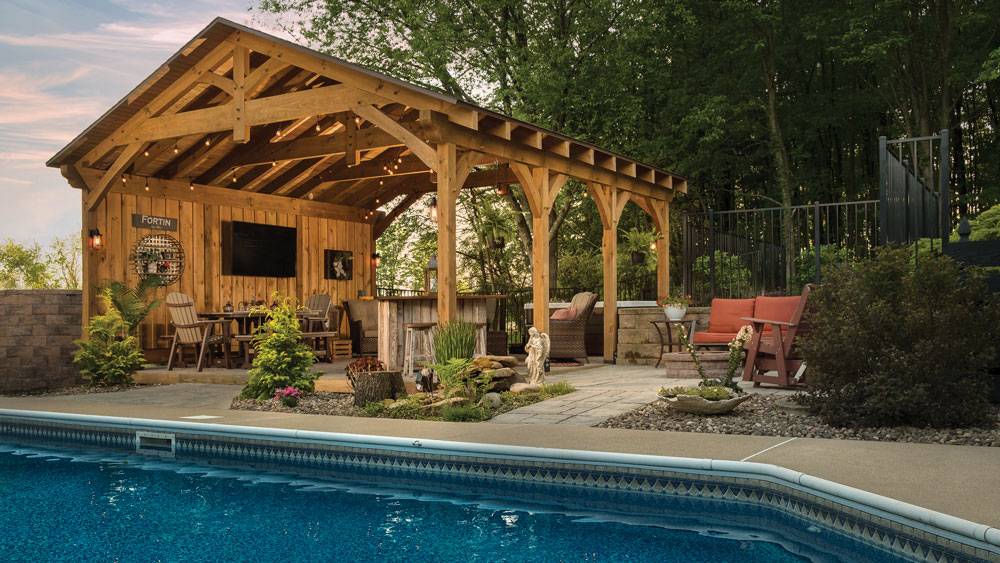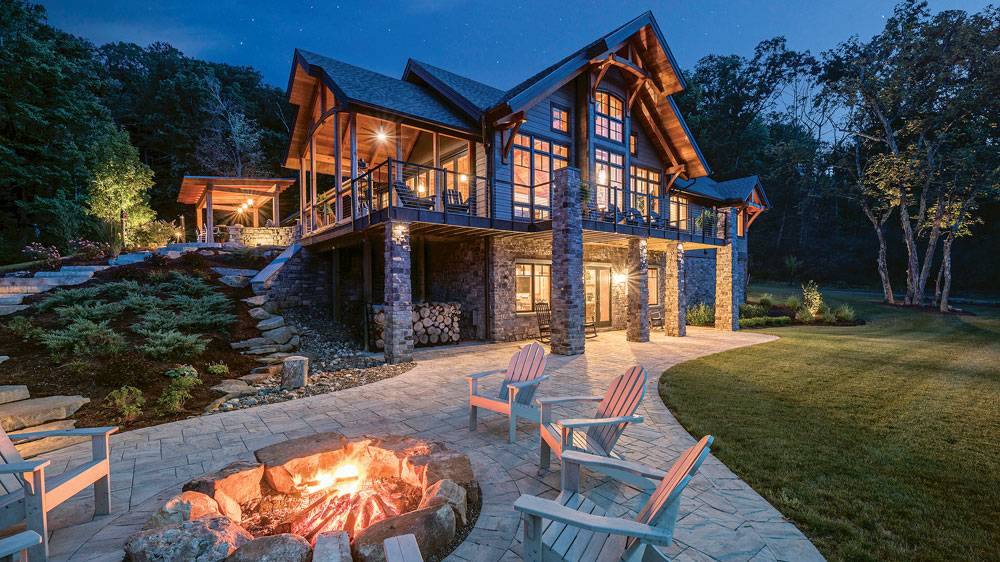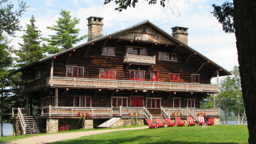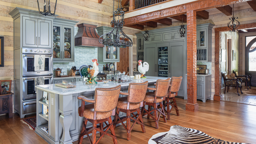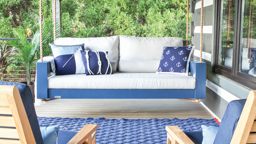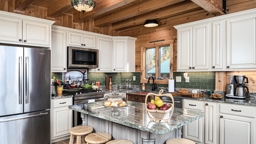Log and timber homeowners are lucky enough to set up camp in some of the most scenic settings in the world — properties with sweeping mountain outlooks or sparkling waterfront views. Naturally, a functional (and fun) place to take in the scenery is a must. Outdoor rooms instantly expand living and entertaining spaces and, in some cases, for only a modest cost. So don’t let your porch, patio or deck go the way of so many dining rooms: looked at but not lived in. Use these pointers to design an outdoor space where you can kick back, relax and take in the views.
Protect It
If simply adding an outdoor room dramatically expands your living space, adding a roof and screening it in ups the ante. A screened-in porch blurs the line between indoors and out. Take a cue from the days of old-fashioned sleeping porches and outfit your three-season room with plush pieces like a daybed covered in indoor-outdoor fabric and plenty of pillows. Not just for afternoon naps and weekend read-a-thons, a screened-in porch can be a particularly pleasant alternative for al fresco dining in buggy climates.
Adding a roof creates the opportunity for statement-making lighting or a ceiling fan, which can make all the difference in hot and humid locales. Plus, if you’re considering an outdoor kitchen, a roof adds a layer of protection for appliances and keeps the sun off your back during hot summer cookouts.
Not only will guests appreciate the protection from the elements, adding a covering to an outdoor space preserves your home as well. Deep overhangs shield your home’s logs and timbers from exposure to harsh elements like sun, wind and rain, ultimately saving you time and money on maintenance.
Connect It
Porches, patios and decks may be timeless, but today’s trends prove they’re also ripe for innovation. Consider the increasingly popular folding-glass walls, like those from NanaWall. These innovative configurations seemingly disappear into the door frame to create a wide-open pass through to outdoor rooms. When incorporated next to open living spaces, a NanaWall significantly increases your entertaining space and eliminates any barriers between inside and out.
If you’re installing a fireplace directly outside a main living space, a two-sided hearth can be a great way to not only extend the porch’s usability through winter, it also creates another connection between indoors and out. Carry the grandeur of your great room out onto your covered porch or re-create the coziness of your kitchen out on your patio.
Enhance It
There’s nothing wrong with simplicity – a few rocking chairs and a symphony of cricket, frog and bird songs as your soundtrack. But if you’re looking for something a bit more hi-tech and high-end, we have a few ideas.
Full-shade, full-sun and cold-hardy no longer refer to landscape plans alone. These are just a few of the tech specs you’ll find on a whole new crop of televisions, designed specifically for outdoor use. Top-of-the-line TVs not only boast eye-popping picture quality and smart-tech features like Wi-Fi and Bluetooth, they also handle heat, humidity, dust, cold and whatever else Mother Nature can throw at them. Before you shop, you’ll need to know where you’ll place the TV, the sun exposure and temperature range of that location and what you’ll be mounting it to.
A new class of outdoor pizza ovens also makes the case for taking family night outside. Innovative, highly portable, high-performing pizza ovens can turn any porch or patio into the hottest spot to grab a bite. (Literally! These ovens reach upwards of 900 degrees, so pick a location with fire-proof surfaces.) Brands like Ooni make a wide variety of models that vary by fuel source, portability and size, but generally ring up at under $1,000, making them an affordable alternative to built-in units.
Finally, furnishing options have come a long way. One of the biggest trends in outdoor design is to create spaces that mirror indoor living areas. Comfort is key, but now you don’t have to compromise on style. Sturdy, long-lasting materials like teak and metals remain popular for good reason, but innovations in synthetic options offer an increasingly diverse variety of shapes and styles to cater to any and every aesthetic. Another way to capture that indoor comfort, particularly if you’re trying to zhush-up your current outdoor space, is to take advantage of gas-fueled fire pit tables, which offer all the luxury of a fire pit or fireplace but are mess-free and save space. (And make quite the modern statement!) Light the fire, pull up a chair and take it all in ... from the outside.
Recipe for Success
If kitchen is the heart of the home, then an outdoor kitchen is the life of the party. Keep guests comfortable with these tips for an outdoor kitchen that can handle the heat.
Key Ingredients.
At the most basic level, a simple outdoor kitchen may feature some prep space and a grill. To level up, consider also including a sink, a compact fridge, a wood-fired oven, extra burners, an enclosed trash bin and a spacious bar with seating. Stainless steel appliances and cabinetry are sure-fire choices for
durability and make clean up a snap. Finally, make sure your floors are fireproof; concrete and stone are safe (and stylish!) options.
Location, Location, Location.
Regardless of whether you have room for a chef’s kitchen or a small-but-mighty kitchenette, there are a few things to consider aside from available space. Views, accessibility and convenient connection to water, gas and electric top the list. Also consider: If you’re building a fully equipped outdoor kitchen, you probably don’t need quick access to your main kitchen. In that case, prioritize the view or proximity to other outdoor elements — a pool, the hot tub or maybe even your garden. For smaller outdoor cooking setups, a convenient proximity to the primary kitchen may not be such a bad thing.
Start Early.
As with most things, an early start is best. If you’re still dreaming and scheming your home’s design, incorporate the outdoor kitchen into your plans as early as possible. It’s much easier to plan and build with electrical, plumbing and gas connections in mind rather than retrofitting later.
Material Matters
Historically, wood has taken top spot when it comes to decking material, with Consumer Reports estimating that half of all U.S. decks are made entirely of wood. But recent economic changes and supply chain shortages have made it more expensive. Composite material – a mix of plastic and wood fiber – may have even more advantages now, aside from the long-lasting, low-maintenance benefits it’s known for. If you’re still committed to the real wood route, one of the most common choices is pressure-treated lumber, which is a less expensive wood that’s been treated with a chemical mix to make it rot- and insect-resistant. It’s easy to work with and boasts a lower cost, but it does require regular maintenance. Considered a step up from pressure-treated lumber, natural wood options like cedar and redwood are also popular, though redwood is harder to come by. And finally, exotic hardwoods like ipe or ironwood offer extra durability (and striking good looks!) but at a much higher cost.






